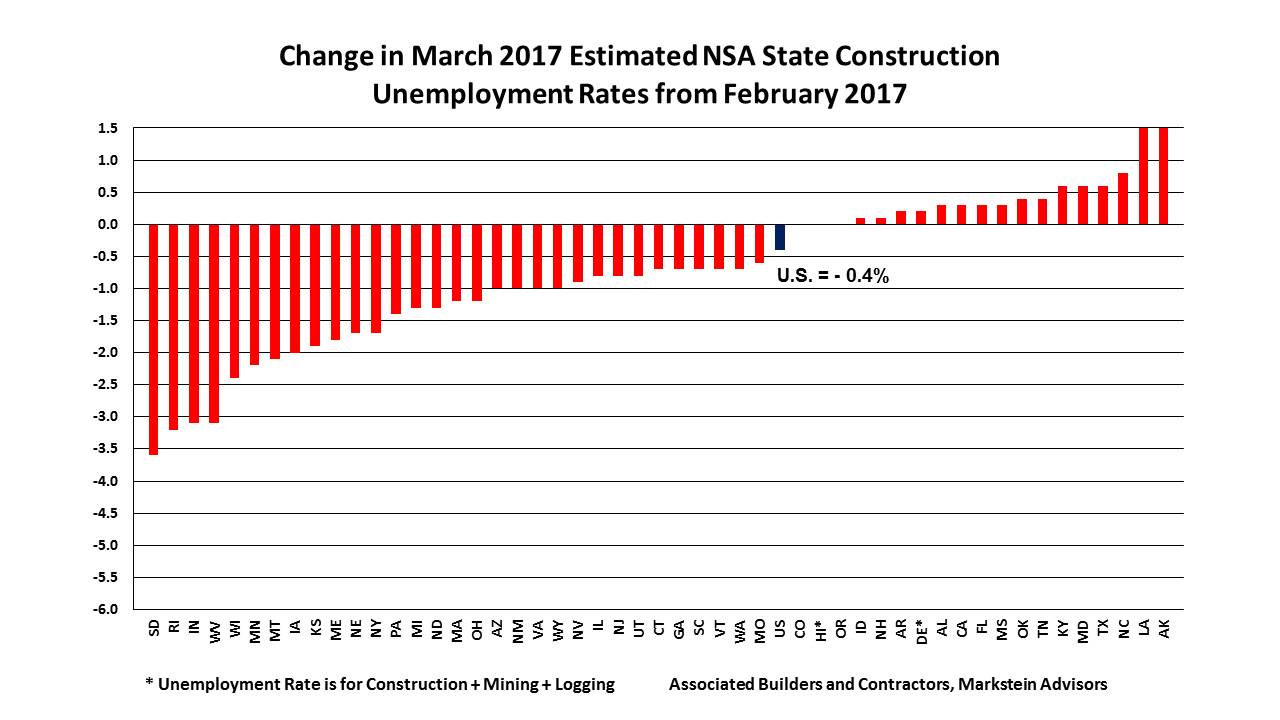Construction Unemployment Rates Improve in 27 States
WASHINGTON, D.C., May 2—March not seasonally adjusted (NSA) construction unemployment rates were down in nationally and in 27 states and unchanged in two on a year-over-year basis, according to analysis released today by Associated Builders and Contractors (ABC). The national NSA construction unemployment rate of 8.4 percent was down 0.3 percent from March 2016, according to data from the U.S. Bureau of Labor Statistics (BLS).
Since these industry-specific rates are not seasonally adjusted, national and state-level unemployment rates are best evaluated on a year-over-year basis.
“This was the lowest national NSA March construction unemployment rate on record, matching the 8.4 percent rate in March 2001,” said Bernard M. Markstein, Ph.D., president and chief economist of Markstein Advisors, who conducted the analysis for ABC. “BLS data also showed that the industry employed 184,000 more workers than in March 2016. In sum, the construction sector remains healthy even as employers cope with shortages of skilled construction workers.”
The general pattern in the movement in the national NSA construction unemployment rate from February to March is a decline. Starting in 2000, when the BLS data for this series begins, through 2016, the March rate has fallen 14 times, risen twice and been unchanged once. In keeping with the normal pattern, despite a return to “normal” weather in March after an unusually mild February in much of the country, this year there was a 0.4 percent rate drop in the NSA rate from February.
View states ranked by their construction unemployment rate, their year-over-year change in construction unemployment, their monthly change in construction unemployment, a regional breakdown of states' construction unemployment rates and their March unemployment rates for all industries.
The Top Five States
The states with the lowest estimated NSA construction unemployment rates in order from lowest rate to highest were:
1. Colorado and Nebraska (tie)
3. Utah
4. Kansas
5. Iowa
Three states—Colorado, Nebraska and Utah—were also among the top five in February.
Colorado and Nebraska, both with a 4.3 percent estimated NSA construction unemployment rate, had the lowest rate among the states. For Colorado, this was a repeat in ranking from February based on revised data (previously reported as the second lowest rate). This was Colorado’s lowest March rate (tied with March 2007) since March 2001’s 3.6 percent rate. For Nebraska, this was an improvement from tying with Idaho for the third lowest rate based on revised data in February (previously reported as the fifth lowest rate). It was also the state’s second lowest March rate (behind last year’s 4.2 percent rate) since 2008’s 3 percent rate.
Utah, with a 4.4 percent construction unemployment rate, had the third lowest March rate, down from second lowest rate in February based on revised data (previously reported as the lowest rate). It was the state’s lowest March estimated rate since the March 2007 rate of 2.6 percent.
Kansas, with a 5.3 percent rate, had the fourth lowest rate in March—much improved from the 13th lowest in February. It was the state’s lowest estimated rate since March 2007’s 4.8 percent rate.
Iowa, with a 5.4 percent rate, had the fifth lowest rate in March. That compares with being tied for the 15th lowest rate with Massachusetts in February. It was also the state’s third lowest March rate after March 2000 (4 percent) and March 2016 (4.5 percent).
Idaho, which was tied with Nebraska for third lowest in February, fell to 10th lowest with a 6.1 percent rate in March. Oregon posted its lowest March rate since the beginning of the state-level estimates in 2000 with a 6.2 percent rate, but it fell from the fifth lowest rate in the country in February to 11th lowest in March, tied with Massachusetts.
The Bottom Five States
The states with the highest NSA construction unemployment rates in order from lowest to highest rates were:
47. Pennsylvania and Rhode Island (tied)
48. Connecticut
49. New Mexico
50. Alaska
Four of these states—Alaska, New Mexico, Rhode Island and Pennsylvania—were also among the five states with the highest construction unemployment rates in February.
As in the previous six months, Alaska had the highest estimated NSA construction unemployment rate in March, 20.9 percent. It should be no surprise that during the cold weather months, Alaska has among the highest rates in the nation since these are NSA construction unemployment rates. The state ended up with two records in March that it would prefer not to have, the largest year-over-year increase (up 2 percent) and the largest monthly increase (up 4.2 percent).
New Mexico had the second highest construction unemployment rate in March, 13.8 percent, compared to the third highest rate in February.
Connecticut had the third highest estimated NSA construction unemployment rate in March, 12.3 percent. In February, the state had the sixth highest rate. Nonetheless, it was the state’s second lowest March rate (after 2016’s 12.2 percent) since March 2007’s 11.5 percent.
Pennsylvania and Rhode Island tied for the fourth highest rate in March, 11.9 percent. In February, Pennsylvania had the fifth highest rate and Rhode Island had the second highest rate. For Pennsylvania, it was the state’s lowest March rate (along with 2008 and 2016) since the 10.1 percent rate in 2007. For Rhode Island it was the state’s lowest March rate since the 10.1 percent rate in 2004. Rhode Island also had the second largest year-over-year decrease in its rate (down 3.3 percent) behind Maine’s 3.4 percent drop and the second largest monthly decrease in its rate (down 3.2 percent) behind South Dakota’s 3.6 percent decrease.
West Virginia, which had the fourth highest construction unemployment rate in February, had the eighth highest rate in March, 10.8 percent. The state, along with Indiana, had the third largest decrease from February, down 3.1 percent. It was also the state’s lowest March rate since 2007 (8.2 percent).
To better understand the basis for calculating unemployment rates and what they measure, see the article Background on State Construction Unemployment Rates.


